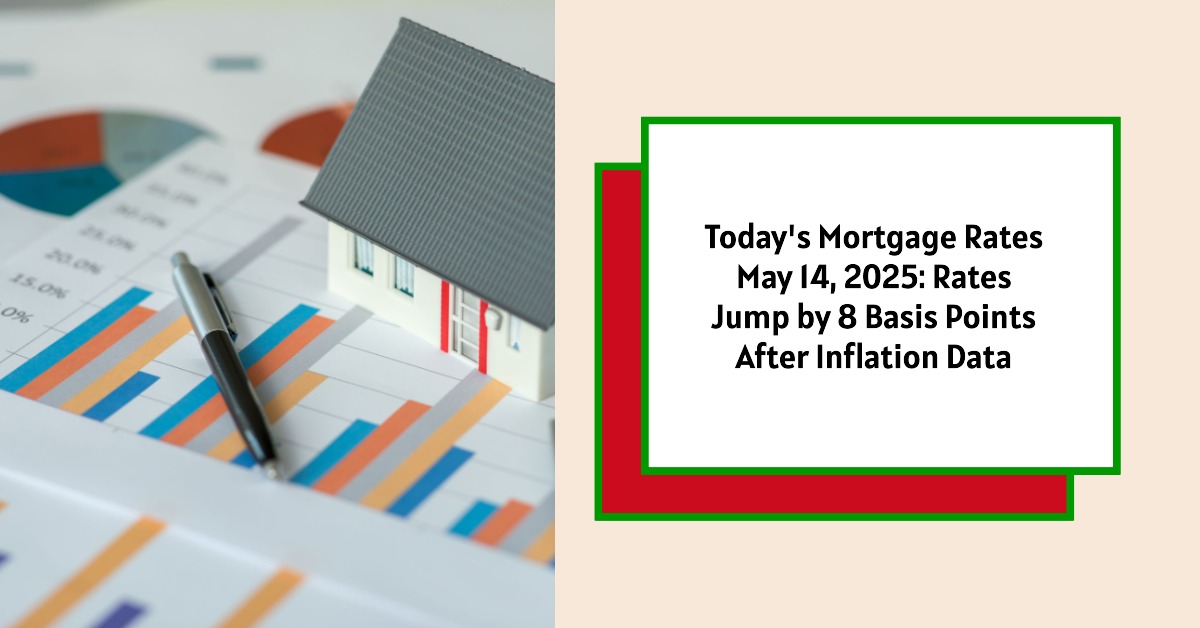Mortgage rates on May 14, 2025, are currently experiencing instability with variations in rates across different loan types. The average rate for a 30-year fixed mortgage stands at 6.84%, showing a slight increase, while the 15-year fixed mortgage has decreased marginally to 6.06%. These fluctuations are significantly influenced by recent inflation reports which indicate that the rate of inflation is slowing down compared to previous months.
Today's Mortgage Rates – May 14, 2025: Rates Jump by 8 Basis Points After Inflation Data
Key Takeaways
- Current Average Rates:
- 30-Year Fixed Mortgage: 6.84% (↑ 8 basis points)
- 15-Year Fixed Mortgage: 6.06% (↓ 1 basis point)
- Texas VA Loan: 5.78% (15-Year Fixed)
- Refinance Rates: Generally higher than new mortgage rates.
- Inflation reports are sparking uncertainty in the mortgage market.
- Experts suggest rates may stabilize as economic conditions evolve.
As of today, mortgage interest rates are notably fluctuating due to various economic indicators and geopolitical factors. The uncertainty following the recent Consumer Price Index (CPI) report is a key driver behind these changes. The CPI, which measures the average change in prices over time, has shown a smaller increase in inflation levels. Specifically, the April CPI indicated that inflation climbed by 2.3%, which is the slowest growth observed since February 2021. This could hint at potential reductions in rates by the Federal Reserve in upcoming meetings if the trend continues.
Table of Today's Mortgage and Refinance Rates (May 14, 2025)
| Loan Type | Current Rate |
|---|---|
| 30-Year Fixed | 6.84% |
| 20-Year Fixed | 6.38% |
| 15-Year Fixed | 6.06% |
| 5/1 ARM | 7.34% |
| 7/1 ARM | 7.42% |
| 30-Year VA | 6.33% |
| 15-Year VA | 5.78% |
| 5/1 VA | 6.50% |
Source: Zillow
| Refinance Loan Type | Current Rate |
|---|---|
| 30-Year Fixed | 6.91% |
| 20-Year Fixed | 6.53% |
| 15-Year Fixed | 6.03% |
| 5/1 ARM | 7.57% |
| 7/1 ARM | 7.43% |
| 30-Year VA | 6.30% |
| 15-Year VA | 5.91% |
| 5/1 VA | 6.35% |
Source: Zillow
Understanding Mortgage Rates
It's crucial to understand what influences these mortgage rates. Over the last several months, various economic factors have affected both purchase and refinance rates.
- Inflation and Monetary Policy: The Federal Reserve often responds to inflation rates by adjusting interest rates. Lower inflation typically leads to decreased interest rates as borrowing becomes cheaper when inflation cools. Conversely, rising tariffs related to trade policies (specifically with China) pose a potential risk for inflation, which may keep mortgage rates elevated throughout the year.
- Market Reactions: The financial markets often react swiftly to economic reports. When the CPI was released, it prompted discussions about possible future rate cuts by the Federal Reserve, leading to a temporary rise in mortgage rates due to market speculation. Investors and lenders closely watch these indicators to adjust their strategies accordingly.
- Global Dynamics: Geopolitical issues, especially related to tariffs, have played a significant role in shaping inflation trends. Recent agreements between the U.S. and China to reduce tariffs temporarily could help stave off a recession. Still, the lingering high tariff rates could keep inflation—and thus mortgage rates—higher.
The Types of Mortgages Available
When it comes to mortgages, there are various options that can cater to different financial situations and goals. Here is an overview of the primary types of mortgages and their characteristics:
- Fixed-Rate Mortgages: These loans maintain a consistent interest rate throughout the loan term, making budgeting easier for homeowners. Two popular types of fixed-rate mortgages include:
- 30-Year Fixed: This is the most common mortgage type. Its lower monthly payments can be a significant advantage for new homeowners. However, borrowers pay more interest over the life of the loan.
- 15-Year Fixed: This option usually offers a lower interest rate than the 30-year fixed. Borrowers pay off their loan faster and accrue less interest, resulting in significant total savings. The main drawback is the higher monthly payments, which may strain budgets.
- Adjustable-Rate Mortgages (ARMs): These loans have a fixed interest rate for an introductory period, after which the rate adjusts periodically based on market conditions.
- For example, a 5/1 ARM maintains a low fixed rate for the first five years before adjusting annually for the balance of the 30 years. While ARMs can initially save borrowers money, they can lead to unpredictable monthly payments if rates trend upwards.
- Government-Backed Loans: These are designed to assist specific types of borrowers, such as veterans or low-income individuals.
- VA Loans: Offered to veterans and active-duty military personnel, these loans typically require no down payment and have favorable terms.
- FHA Loans: These are designed for lower-income borrowers with less-than-perfect credit. FHA loans have more lenient requirements but come with mortgage insurance premiums.
Read More:
Mortgage Rates Trends as of May 13, 2025
Dave Ramsey Predicts Mortgage Rates Will Probably Drop Soon in 2025
Future of Mortgage Rates Post-Fed Decision: Will Rates Drop?
Fed's Decision Signals Mortgage Rates Won't Go Down Significantly
The Impact of Economic Reports
The impact of economic reports on mortgage rates cannot be understated. When important data, such as the CPI, unemployment rates, or worker wage growth, is released, it can cause immediate reactions in the mortgage market. For instance, if inflation rises unexpectedly, lenders might increase rates preemptively, anticipating that the Federal Reserve will tighten monetary policy in response.
Conversely, when inflation stabilizes or falls, as it did according to the recent CPI report, mortgage rates tend to stabilize or decrease. However, the significance of this stabilization is often tempered by other factors, such as ongoing trade discussions with China.
Expert Forecasts for Future Rates
Looking ahead, various organizations, including Fannie Mae and the Mortgage Bankers Association (MBA), provide predictions about mortgage rates. As previously mentioned, both groups have adjusted their forecasts for 2025. These predictions are not guarantees but provide insight into potential trends based on current data.
| Forecaster | Q2 2025 | Q3 2025 | Q4 2025 | Q1 2026 |
|---|---|---|---|---|
| Fannie Mae | 6.50% | 6.30% | 6.20% | 6.10% |
| MBA | 7.00% | 6.80% | 6.70% | 6.60% |
The forecasts from Fannie Mae and the MBA often take into account employment figures, economic growth, and inflation expectations. While they signal potential declines in rates, the actual outcome remains contingent upon a variety of unpredictable factors.
Market Behavior Following Economic Changes
The mortgage market is notable for its volatility, characterized by sharp changes in rates based on shifting investor sentiment in response to economic developments. The constant flow of news—from geopolitical events to local economic indicators—can drive sudden shifts in demand for mortgage products, further influencing rates.
For instance, discussions regarding an economic downturn or favorable employment statistics can lead lenders to adjust their offerings. The response often involves a recalibration of rates, reflecting changes in perceived risk among lenders.
Refinancing Trends
Refinancing can be an appealing option for homeowners who wish to lower their monthly payments or tap into their home equity. According to current data, refinancing rates often appear slightly higher than those for purchasing new homes, making it important for homeowners to evaluate if refinancing is beneficial in their specific circumstances.
The current average refinance rates on May 14, 2025, indicate that homeowners may still find attractive offers relative to historical trends:
- The 30-year refinance rate is at 6.91%, offering options for borrowers with an existing mortgage looking to save on payments or obtain cash for home renovations.
- The 15-year refinance rate stands at 6.03%, appealing to those interested in paying off their loans faster and with a lower interest cost.
Summary:
Today's mortgage landscape is undoubtedly complex. The interplay of inflation rates, political shifts, and economic forecasts contributes to a fluid environment for both purchasing and refinancing homes. Understanding these aspects can help potential homebuyers and current homeowners make informed decisions.
For those navigating the mortgage process, tools like mortgage calculators can provide a clearer picture of how varying rates influence monthly payments. Overall, the expectation is that while some fluctuations are expected, the overarching trend may lead to stabilization in the coming months as inflation and economic indicators become more predictable.
Invest Smarter in a High-Rate Environment
With mortgage rates remaining elevated this year, it's more important than ever to focus on cash-flowing investment properties in strong rental markets.
Norada helps investors like you identify turnkey real estate deals that deliver predictable returns—even when borrowing costs are high.
HOT NEW LISTINGS JUST ADDED!
Connect with a Norada investment counselor today (No Obligation):
(800) 611-3060
Also Read:
- Will Mortgage Rates Go Down in 2025: Morgan Stanley's Forecast
- Expect High Mortgage Rates Until 2026: Fannie Mae's 2-Year Forecast
- Mortgage Rate Predictions 2025 from 4 Leading Housing Experts
- Mortgage Rates Forecast for the Next 3 Years: 2025 to 2027
- 30-Year Mortgage Rate Forecast for the Next 5 Years
- 15-Year Mortgage Rate Forecast for the Next 5 Years
- Why Are Mortgage Rates Going Up in 2025: Will Rates Drop?
- Why Are Mortgage Rates So High and Predictions for 2025
- Will Mortgage Rates Ever Be 3% Again in the Future?
- Mortgage Rates Predictions for Next 2 Years
- Mortgage Rate Predictions for Next 5 Years
- Mortgage Rate Predictions: Why 2% and 3% Rates are Out of Reach
- How Lower Mortgage Rates Can Save You Thousands?
- How to Get a Low Mortgage Interest Rate?
- Will Mortgage Rates Ever Be 4% Again?



